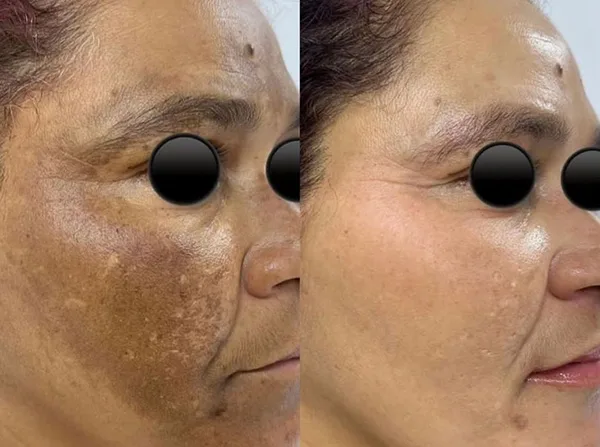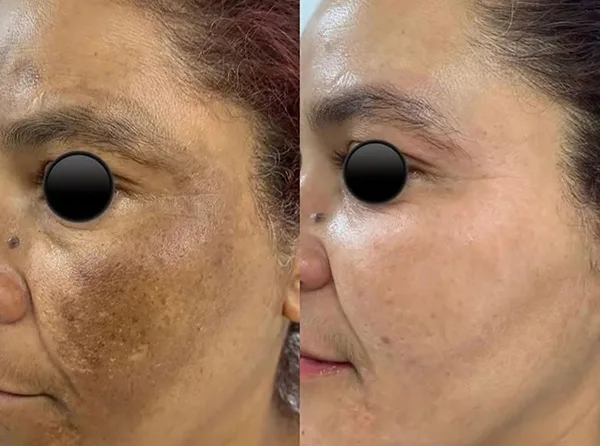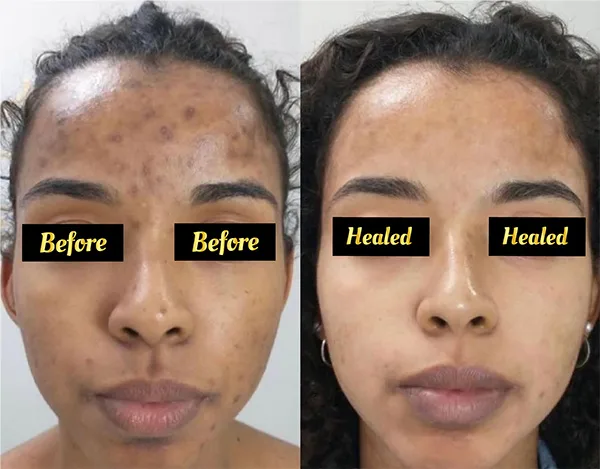Melasma Treatment in Nairobi, Kenya
Melasma is a common skin condition characterized by brown or gray-brown patches on the face, particularly on the cheeks, forehead, chin, and upper lip. It is more common in women and is often associated with hormonal changes, such as those that occur during pregnancy or with the use of hormonal contraceptives. However, it can also affect men.
The exact cause of melasma is not fully understood, but factors such as sun exposure, hormonal fluctuations, genetic predisposition, and certain medications or cosmetics can contribute to its development. Sun exposure is particularly significant, as ultraviolet (UV) radiation can stimulate the production of melanin, the pigment responsible for skin color, leading to darkening of the patches.
Melasma does not typically cause any symptoms other than the cosmetic concern of the dark patches. However, it can have a significant impact on self-esteem and quality of life for those affected.
Treatment for melasma often involves a combination of topical medications, such as hydroquinone, tretinoin, corticosteroids, or other lightening agents, along with strict sun protection measures, including wearing sunscreen with a high SPF and avoiding excessive sun exposure. In some cases, procedures like chemical peels, microdermabrasion, or laser therapy may be recommended to help lighten the patches.
It’s important for individuals with melasma to work closely with a dermatologist or skincare professional to develop a personalized treatment plan tailored to their specific needs and concerns. While melasma can be challenging to treat and may require ongoing management, many people are able to achieve significant improvement in the appearance of their skin with the right approach.
types of Melasma
Melasma is typically classified into different types based on the distribution and patterns of pigmentation on the skin. The main types of melasma include:
- Epidermal Melasma: This type of melasma involves pigmentation primarily in the epidermal layer of the skin, which is the outermost layer. It presents as brown or tan patches with well-defined borders and is often more responsive to treatment compared to other types of melasma.
- Dermal Melasma: Dermal melasma occurs deeper in the dermal layer of the skin, which is the middle layer. It appears as blue-gray patches with less defined borders and can be more challenging to treat than epidermal melasma.
- Mixed Melasma: Mixed melasma involves a combination of pigmentation in both the epidermal and dermal layers of the skin. It presents as a combination of brown or tan patches with blue-gray patches, often with variable borders. Mixed melasma may require a combination of treatment approaches to achieve optimal results.
- Malar Melasma: Malar melasma, also known as centrofacial melasma, primarily affects the cheeks and central face area, including the forehead, nose, and upper lip. It is the most common type of melasma and is often associated with sun exposure and hormonal factors, such as pregnancy or birth control pills.
- Mandibular Melasma: Mandibular melasma involves pigmentation along the jawline and chin area. It can occur alone or in combination with malar melasma and is more commonly seen in individuals with darker skin types.
- Extrafacial Melasma: Extrafacial melasma refers to pigmentation that occurs outside of the face, such as on the neck, chest, arms, or other sun-exposed areas of the body. It may occur in isolation or in conjunction with facial melasma and is often associated with chronic sun exposure.
These types of melasma may present differently in individuals and may require tailored treatment approaches based on factors such as the depth of pigmentation, the extent of sun damage, hormonal influences, and individual skin characteristics. Consulting with one of our professionals is essential for accurate diagnosis and personalized treatment planning.
Considerations before undergoing Melasma Treatment Procedures
Before undergoing any melasma treatment procedures, it’s essential to consider several factors to ensure the best possible outcomes and minimize potential risks. Here are some key considerations:
- Consultation with a Professional: Schedule a consultation with a Professional who specializes in treating melasma. At Rebel Inks Tattoos, Tattoo Removal, and Body Piercings Parlour, our specialists will assess your skin condition, discuss your treatment goals, and recommend the most appropriate treatment options based on your specific needs and medical history.
- Underlying Causes and Triggers: Understand the underlying causes and triggers of your melasma, such as hormonal fluctuations, sun exposure, genetics, or certain medications. Addressing these factors can help prevent recurrence and optimize treatment outcomes.
- Realistic Expectations: Have realistic expectations about the results of melasma treatment. While many treatments can improve the appearance of melasma, complete resolution may not always be possible. Our specialists can provide guidance on what to expect based on the chosen treatment plan.
- Potential Side Effects and Risks: Educate yourself about the potential side effects and risks associated with the chosen treatment procedures. Depending on the treatment modality, side effects may include redness, irritation, swelling, hyperpigmentation, or scarring. Discuss these risks with your dermatologist and weigh them against the potential benefits.
- Treatment Timeline and Maintenance: Understand the treatment timeline and any required maintenance sessions. Some treatments may require multiple sessions spaced over several weeks or months to achieve optimal results. Additionally, ongoing maintenance treatments may be necessary to sustain the improvement in melasma over time.
- Sun Protection: Emphasize the importance of sun protection before, during, and after melasma treatment. Sun exposure can worsen melasma and interfere with treatment outcomes. Wear sunscreen with a high SPF, seek shade, wear protective clothing, and avoid outdoor activities during peak sun hours to minimize sun damage.
- Skin Type and Sensitivity: Consider your skin type and sensitivity when choosing melasma treatment options. Certain treatments may be more suitable for specific skin types or may cause more irritation in sensitive skin. At Rebel Inks Tattoos, Tattoo Removal, and Body Piercings Parlour, our specialists will recommend customized treatment plans tailored to your skin’s needs.
- Cost and Insurance Coverage: Evaluate the cost of melasma treatment procedures and whether they are covered by insurance. Some treatments may be expensive and not covered by insurance, so it’s essential to budget accordingly and explore payment options with your chosen specialist.
By carefully considering these factors and working closely with our qualified professionals, you can make informed decisions about melasma treatment and achieve the best possible outcomes for your skin.
Melasma Treatment Procedure
Melasma, a common skin condition characterized by patches of discoloration on the face, often requires a multifaceted approach for treatment. Here are some common methods:
Topical Treatments
Topical treatments are often the first line of defense for managing melasma. Here are some commonly used options:
- Hydroquinone: This is one of the most commonly prescribed treatments for melasma. It works by inhibiting the enzyme responsible for melanin production in the skin, thus lightening the dark patches. Hydroquinone creams are available in different strengths, and they are usually applied once or twice daily for several weeks to months.
- Tretinoin: Also known as retinoic acid or Retin-A, tretinoin is a topical retinoid that promotes skin cell turnover and exfoliation. It can help improve the appearance of melasma by encouraging the shedding of pigmented skin cells and promoting the growth of new, evenly pigmented skin cells. Tretinoin is often used in combination with other lightening agents like hydroquinone for better results.
- Corticosteroids: Topical corticosteroids may be prescribed in combination with other treatments to reduce inflammation and enhance the effectiveness of lightening agents. They can help improve the penetration of other topical medications and reduce skin irritation.
- Azelaic Acid: This naturally occurring acid is derived from grains like wheat, rye, and barley. It works by inhibiting melanin production and has anti-inflammatory properties, making it effective for treating melasma. Azelaic acid is available in prescription-strength creams or gels and can be used alone or in combination with other treatments.
- Kojic Acid: This natural ingredient is derived from certain fungi and is known for its skin-lightening properties. Kojic acid inhibits the production of melanin by blocking the activity of tyrosinase, the enzyme involved in melanin synthesis. It is available in various skincare products, including creams, serums, and soaps.
When using topical treatments for melasma, it’s essential to follow your dermatologist’s recommendations regarding application frequency, duration, and sun protection. Some treatments may cause skin irritation or sensitivity, especially in the early stages of use, so it’s crucial to monitor your skin’s response and adjust your skincare routine accordingly. Additionally, consistent use of sunscreen with a high SPF is essential to prevent further darkening of melasma patches caused by sun exposure.
Chemical Peels
Chemical peels can be an effective treatment option for melasma, particularly for those who haven’t responded well to topical treatments alone. Here’s how they work and what you can expect:
How Chemical Peels Work
Chemical peels involve applying a chemical solution to the skin, which causes the outer layers of the skin to peel off, revealing smoother, more evenly pigmented skin underneath. The peeling process also stimulates the growth of new skin cells, which can help improve the appearance of melasma.
Types of Chemical Peels:
There are several types of chemical peels available, ranging from mild to deep:
- Superficial Peels: These peels use mild acids, such as alpha hydroxy acids (AHAs) or beta hydroxy acids (BHAs), to exfoliate the outermost layer of the skin. Superficial peels are generally well-tolerated and require little to no downtime.
- Medium Peels: Medium-depth peels penetrate deeper into the skin than superficial peels and typically use stronger acids, such as trichloroacetic acid (TCA). They can provide more significant improvement in melasma but may require some downtime for recovery as the skin peels and heals.
- Deep Peels: Deep chemical peels penetrate even further into the skin and often use phenol as the peeling agent. These peels can produce dramatic results but are more invasive and require more extensive downtime.
Benefits of Chemical Peels for Melasma:
- Lightening of pigmented patches: Chemical peels can help break up melanin deposits in the skin, leading to a reduction in the appearance of melasma.
- Improved skin texture and tone: Chemical peels can also improve overall skin texture and tone by promoting the growth of new, healthy skin cells.
- Enhanced penetration of topical treatments: By removing the outer layer of the skin, chemical peels can improve the penetration of topical lightening agents, enhancing their effectiveness.
What to Expect:
During a chemical peel treatment, your dermatologist will apply the chemical solution to your skin and leave it on for a specific amount of time, depending on the type of peel used and your skin’s response. You may experience a tingling or burning sensation during the treatment, which is normal and typically subsides quickly.
After the peel, you may notice some redness, peeling, and mild discomfort as your skin heals. It’s essential to follow your dermatologist’s post-treatment instructions carefully, which may include avoiding sun exposure, using moisturizers and gentle cleansers, and applying sunscreen regularly.
It’s important to note that multiple sessions of chemical peels may be needed to achieve the desired results, and maintenance treatments may be necessary to sustain the improvement in melasma over time. Additionally, chemical peels may not be suitable for everyone, so it’s essential to consult with a dermatologist to determine if they are the right option for you.
Laser Therapy
Laser therapy is another treatment option for melasma, particularly for cases that haven’t responded well to topical treatments or chemical peels. Here’s how it works and what you can expect:
How Laser Therapy Works
Laser therapy for melasma involves using concentrated beams of light to target and break up melanin deposits in the skin. Different types of lasers can be used for this purpose, including fractional lasers and intense pulsed light (IPL) devices. These lasers work by delivering energy to the skin, which is absorbed by the melanin, causing it to fragment and be eliminated by the body’s natural processes.
Types of Laser Therapy for Melasma:
- Fractional Laser Therapy: Fractional lasers deliver precise beams of light into the skin, targeting small areas while leaving surrounding tissue unaffected. This type of laser therapy is particularly effective for treating melasma because it can penetrate deep into the skin to target pigment deposits. Fractional lasers stimulate collagen production and promote skin renewal, leading to improvements in texture and tone. Common fractional lasers used for melasma treatment include fractional CO2 lasers and fractional erbium lasers.


- Non-Ablative Laser Therapy: Non-ablative lasers work by heating the deeper layers of the skin without damaging the outer layer. This stimulates collagen production and can help improve the appearance of melasma by promoting skin renewal and reducing pigment irregularities. Non-ablative lasers are less invasive than ablative lasers and typically require minimal downtime. Examples include Nd:YAG lasers and diode lasers.
- Intense Pulsed Light (IPL) Therapy: Although technically not a laser, IPL therapy uses broad-spectrum light to target melanin in the skin. IPL devices emit multiple wavelengths of light, allowing them to target a range of pigmentation concerns, including melasma. IPL therapy can break up pigment deposits and stimulate collagen production, leading to improvements in skin tone and texture. IPL treatments are less invasive than laser therapy and typically require minimal downtime.
- Q-Switched Lasers: Q-switched lasers emit short pulses of high-energy light, specifically targeting pigment deposits in the skin. They are commonly used to treat hyperpigmentation disorders like melasma, as well as tattoo removal. Q-switched lasers can effectively break up melanin deposits without causing significant damage to surrounding tissue. Examples include Q-switched Nd:YAG lasers and Q-switched ruby lasers.
- Fractional Radiofrequency (RF) Therapy: Fractional RF therapy uses radiofrequency energy to heat the deeper layers of the skin, stimulating collagen production and promoting skin renewal. Fractional RF devices create tiny microthermal zones in the skin, which can help improve the appearance of melasma by reducing pigment irregularities and promoting even skin tone. Fractional RF therapy is less invasive than laser therapy and typically requires minimal downtime.
Learn more about Melasma Laser Treatments →
Benefits of Laser Therapy for Melasma:
- Targeted treatment: Laser therapy can precisely target melanin deposits in the skin, leading to more even pigmentation and a reduction in the appearance of melasma.
- Minimal downtime: Depending on the type of laser used and the intensity of the treatment, downtime following laser therapy for melasma is usually minimal, with most people able to resume normal activities shortly after treatment.
- Stimulated collagen production: Laser therapy can also stimulate the production of collagen in the skin, leading to improvements in skin texture and tone.
What to Expect:
During a laser therapy session, your dermatologist will use a handheld device to deliver laser energy to the affected areas of your skin. You may experience some discomfort during the treatment, which can be mitigated with the use of topical numbing cream or cooling techniques.
After the treatment, you may notice some redness, swelling, and mild discomfort in the treated area, similar to a sunburn. These side effects typically subside within a few days to a week. It’s essential to follow your dermatologist’s post-treatment instructions carefully, which may include avoiding sun exposure, using moisturizers and gentle cleansers, and applying sunscreen regularly.
Multiple sessions of laser therapy may be needed to achieve the desired results, and maintenance treatments may be necessary to sustain the improvement in melasma over time. Additionally, laser therapy may not be suitable for everyone, so it’s essential to consult with a dermatologist to determine if it’s the right option for you.
Microdermabrasion
Microdermabrasion is a non-invasive cosmetic procedure that can help improve the appearance of melasma by exfoliating the outer layer of the skin. Here’s how it works and what you can expect from the treatment:
How Microdermabrasion Works:
During a microdermabrasion treatment, a handheld device with a diamond-tipped or crystal-tipped applicator is used to gently exfoliate the outer layer of the skin. This exfoliation removes dead skin cells, including those containing excess pigment, helping to lighten the appearance of melasma patches and promote the growth of new, evenly pigmented skin cells.
Benefits of Microdermabrasion for Melasma:
- Exfoliation: Microdermabrasion effectively exfoliates the skin, helping to remove pigmented cells and promote a more even skin tone.
- Minimal downtime: Microdermabrasion is a non-invasive procedure that typically requires little to no downtime. Most people can resume their normal activities immediately after treatment.
- Improved product absorption: By removing the outer layer of dead skin cells, microdermabrasion can enhance the penetration and effectiveness of topical treatments for melasma.
What to Expect:
During a microdermabrasion treatment, your skincare professional will gently move the handheld device across your skin, targeting the areas affected by melasma. You may feel a mild scratching or vibrating sensation during the procedure, but it should not be painful.
After the treatment, you may experience some redness and mild irritation, similar to a sunburn. These side effects typically subside within a few hours to a day. It’s essential to follow your skincare professional’s post-treatment instructions carefully, which may include using moisturizers and gentle cleansers and applying sunscreen regularly.
Multiple sessions of microdermabrasion may be needed to achieve the desired results, and maintenance treatments may be necessary to sustain the improvement in melasma over time. Additionally, microdermabrasion may not be suitable for everyone, so it’s essential to consult with a skincare professional to determine if it’s the right option for you.
Cosmetic Camouflage:
Cosmetic camouflage is a technique used to conceal the appearance of melasma patches using makeup products specifically designed for this purpose. Here’s how it works and what you can expect:
How Cosmetic Camouflage Works:
Cosmetic camouflage involves using specially formulated makeup products to cover up the dark patches caused by melasma. These products typically include highly pigmented concealers, foundations, and setting powders that provide long-lasting coverage and blend seamlessly with the skin.
Benefits of Cosmetic Camouflage for Melasma:
- Immediate results: Cosmetic camouflage can provide immediate coverage of melasma patches, helping to improve the appearance of the skin without the need for invasive procedures or long-term treatments.
- Customizable coverage: Makeup products used for cosmetic camouflage can be layered and blended to achieve the desired level of coverage, allowing individuals to tailor their makeup routine to their specific needs and preferences.
- Temporary solution: Cosmetic camouflage offers a temporary solution for covering up melasma patches, providing relief from the visible signs of the condition while other treatment methods are being pursued or as a complement to ongoing treatments.
What to Expect:
To use cosmetic camouflage for melasma, start by applying a color-correcting concealer or primer to neutralize the dark pigmentation of the melasma patches. Then, apply a high-coverage foundation or concealer that matches your skin tone over the affected areas, blending it evenly for a seamless finish. Finally, set the makeup with a translucent setting powder to help it stay in place throughout the day.
It’s essential to choose makeup products that are non-comedogenic and suitable for sensitive skin to avoid aggravating melasma or causing further irritation. Additionally, be sure to remove makeup thoroughly at the end of the day to allow your skin to breathe and prevent clogged pores.
While cosmetic camouflage can help improve the appearance of melasma temporarily, it’s important to remember that it does not treat the underlying cause of the condition. For long-term improvement, it’s recommended to pursue other treatment options in consultation with a dermatologist or skincare professional.
Schedule Appointment
Melasma Treatment Aftercare
After undergoing melasma treatment, proper aftercare is essential to promote healing, minimize side effects, and maintain the results. Here are some general guidelines for melasma treatment aftercare:
- Sun Protection: Protect your skin from sun exposure as much as possible, as UV radiation can worsen melasma and interfere with treatment results. Wear sunscreen with a high SPF (at least 30) every day, even on cloudy days, and reapply it every two hours when outdoors. Wear protective clothing, such as wide-brimmed hats and sunglasses, and seek shade when possible.
- Avoid Sun Exposure: Limit your time spent in direct sunlight, especially during peak hours (10 a.m. to 4 p.m.). If you must be outdoors, take extra precautions to protect your skin, such as wearing sunscreen, protective clothing, and seeking shade.
- Moisturize: Keep your skin hydrated by applying a gentle, non-comedogenic moisturizer regularly. Moisturizing can help soothe any dryness or irritation caused by treatment and promote skin healing.
- Avoid Irritants: Avoid using harsh skincare products, such as exfoliants, scrubs, or products containing alcohol or fragrances, as they can irritate the skin and worsen melasma. Stick to gentle, non-irritating skincare products recommended by your dermatologist.
- Follow Post-Treatment Instructions: Follow any specific post-treatment instructions provided by your dermatologist or skincare professional. This may include avoiding certain skincare ingredients, avoiding excessive heat or sweating, and refraining from picking or scratching at the treated area.
- Stay Hydrated: Drink plenty of water to keep your skin hydrated from the inside out. Hydration is essential for maintaining healthy skin and supporting the skin’s natural healing process.
- Avoid Smoking and Alcohol: Smoking and excessive alcohol consumption can have a negative impact on skin health and interfere with the healing process. Try to avoid smoking and limit alcohol intake during the recovery period.
- Be Patient: Be patient with the healing process and give your skin time to recover. Results from melasma treatments may take several weeks or months to become fully apparent, so continue to follow your aftercare routine and be consistent with any prescribed treatments.
- Follow-up Appointments: Attend any scheduled follow-up appointments with your dermatologist or skincare professional to assess your progress and determine if additional treatments or adjustments to your skincare routine are needed.
By following these aftercare guidelines and maintaining a healthy skincare routine, you can help optimize the results of your melasma treatment and support the long-term health and appearance of your skin. If you have any concerns or experience unexpected side effects, be sure to contact your dermatologist for further guidance.
OUR LOCATION
Areas We Serve
NAIROBI
KIAMBU
KAJIADO
MACHAKOS


